33 Keys to Decoding the Korean Wave, Hallyu #11 'Squid Game' & 'The Kingdom of Games'
33 Keys to Decoding the Korean Wave, Hallyu #11 Homo Ludens Koreans
'Squid Game' and 'The Kingdom of Games'
*한류를 이해하는 33가지 코드 #11 '오징어 게임'과 '놀이의 왕국' <한국어 버전, Korean version>
http://www.nyculturebeat.com/index.php?mid=Focus&document_srl=4077302
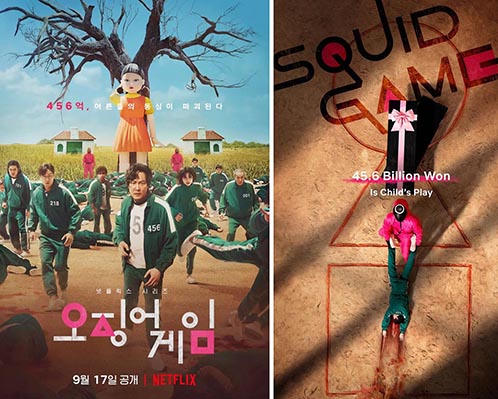
Posters for the Netflix global hit drama series “Squid Game”
K-Drama Squid Game Sweeps the Emmys
In 2020, Bong Joon-ho’s Parasite made history by sweeping four Academy Awards, including Best Picture, Best Director, Best Screenplay, and Best International Feature Film. The following year, Minari, directed by Lee Isaac Chung, brought further acclaim to Korean cinema, with Youn Yuh-jung earning an Academy Award for Best Supporting Actress. Then, at the 2022 Emmy Awards, Squid Game won Best Director (Hwang Dong-hyuk), Best Actor (Lee Jung-jae), Best Guest Actress (Lee Yu-mi), Best Production Design, Best Visual Effects, and Best Stunt Performance.
The nine-part series premiered on Netflix on September 17, 2021, amassing an unprecedented 2.252 billion viewing hours, the highest in Netflix history. Squid Game Season 2, released on December 26, 2024, shattered records, ranking first in 92 countries within a day of airing and achieving 68 million views in just four days—a new milestone for Netflix. Like Parasite, Hwang Dong-hyuk’s Squid Game explores the stark divide between rich and poor in a capitalist society, delivering a chilling commentary on survival and inequality. Notably, Hwang Dong-hyuk was previously blacklisted by the Korean government, alongside director Bong Joon-ho and Nobel Prize-winning author Han Kang.
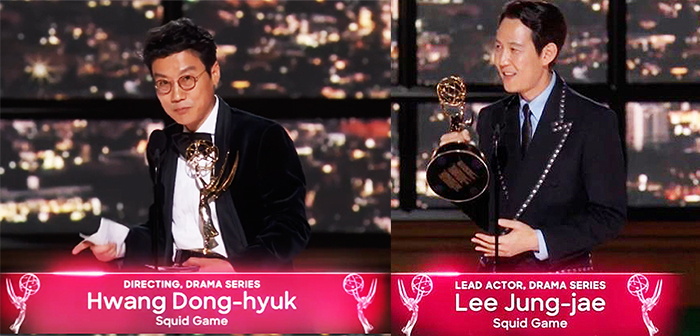
Director Hwang Dong-hyuk and actor Lee Jung-jae made history at the 74th Emmys.
Korean Games in Squid Game
In Squid Game, 456 adults desperate to escape financial despair participate in a deadly, winner-takes-all competition for a prize of 45.6 billion won. The series introduces traditional Korean childhood games from the 1970s and 80s, blending horror and suspense. These games demand agility, concentration, balance, and physical strength, set against a pastel-colored playground turned macabre battleground.
In the first episode of Squid Game, Ki-hoon (played by Lee Jung-jae) goes to the horse racetrack to gamble on his daughter’s birthday. Gambling is a pure Korean word for “norum,” a noun form of “nolda (play).” Money betting “norum (gambling)” is more dangerous than “nori (play).”
Season 1 showcased games like Ddakji(딱지), Green Light Red Light(무궁화꽃이 피었습니다), Dalgona(설탕뽑기), Tug of War(줄다리기), Marbles(구슬치기), Glass Bridge(징검다리 건너기), and the titular Squid Game(오징어). The Dalgona game, which involves carefully removing shapes from sugar candies with a needle, sparked a global trend. Dalgona plucking kits sold out, YouTube tutorials went viral, and TikTok users participated in survival-style challenges. In New York City, the Michelin-starred Korean restaurant Cote hosted a Dalgona challenge, and Dalgona-themed desserts appeared on menus at Nowon restaurant and Noona Ice Cream.
Season 2, which returned after three years, introduced additional games, including Rock Paper Scissors-One Minus, Russian Roulette, and traditional Korean folk games like Gong-gi, Biseok (Flying Stone), Paeng-y (Spinning Top), and Jegi. The Six-Legged Pentathlon, where participants tied their ankles in teams of five, and Mingle created suspense-filled competition.

Games in Squid Game 1. Image: Netflix
Viral Game Scenes and Social Media Craze
A scene featuring Dae-ho playing Gong-gi captivated audiences and went viral on social media. The British Radio Times highlighted the simplicity of the game, which can be played with stones, pebbles, dice, beads, or any other small round objects. Geum-ja, a character in the series, even claimed to have played it with bullets during the Korean War. Renewed interest in Korean traditional games fueled sales of Gong-gi balls on platforms like Amazon, alongside Six-Legged Pentathlon Game Sets featuring Gong-gi, Ddakji, Paeng-y, Jegi, and Biseok.
Season 2’s Mingle game also captured viewers' imaginations. Set to the haunting nursery rhyme “Round and Round,” participants must pair up on a rotating disc like a merry-go-round and enter designated rooms within 30 seconds—or face elimination. The suspenseful juxtaposition of a children’s choir with the deadly stakes captivated audiences, sparking viral "mingle dance" challenges to the song on social media.
Squid Game has not only redefined K-Drama but also revived traditional Korean games, introducing them to a global audience. The series' intricate blend of nostalgia, suspense, and commentary on societal inequality continues to resonate, demonstrating the universal appeal of Korean culture.
Korean Games: From Tradition to Global Phenomenon
And on September 9, 2022, four days before the Emmy Awards ceremony, the Los Angeles City Council officially declared September 17th as “Squid Game Day,” which Korean-American LA Councilmember John Lee introduced. The proclamation is part of AAPI (Asian American and Pacific Islander) LA, a city initiative intended to amplify AAPI community voices, which reads “Squid Game marks another victory in the fight to grow representation of the AAPI community in film and entertainment, exposing audiences to Korean culture and traditions while paving the way for other AAPI communities to also have their stories told.”
Long before Netflix’s Squid Game became a global sensation, Korea had already established itself as a leader in the online gaming industry. This success builds on a deep-rooted cultural affinity for games and play. American curator and ethnographer Stewart Culin (1858–1929) recognized Korea’s prominence in this realm over a century ago. In his 1895 book Korean Games: With Comparisons to Chinese and Japanese Games, Culin argued that Yut—a traditional Korean board game—served as the prototype for many games worldwide, providing detailed descriptions of 95 traditional Korean games.
Dutch cultural historian Johan Huizinga (1872–1945) explored the significance of play in his influential book Homo Ludens (1938), asserting that games are foundational to the development of human culture. This perspective sheds light on why the Korean people, with their rich history of entertainment culture, have excelled not only in gaming but also in broader cultural arenas like K-pop, K-dramas, and K-movies. The global success of Squid Game is a modern testament to Korea’s enduring legacy of creativity and play, bridging traditional pastimes with contemporary storytelling.
“K-Game” ... No. 1 export of Hallyu content
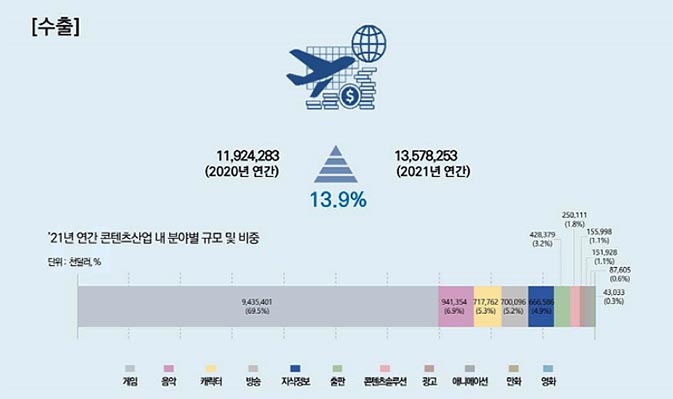
Contents industry export scale in 2021 (Korea Creative Content Agency)
When we think of Hallyu, K-Pop, K-Drama, K-Movie, K-Food, and K-Beauty come to mind. However, in fact, the number one contributor to Hallyu exports is the Game contents. “Made in Korea” online, video, and mobile game industries accounted for about 70% of content exported in 2021 from Korea. According to the Korea Creative Content Agency (KOCCA), the content industry exports in 2021 were $13.588 billion, up 13.9% from 2020. By field, K-Game recorded $9,435 billion (69.2%), far ahead of K-Pop (6.9%) and K-Movie (1.1%). Online games are the No. 1 content for K-Wave exports.
In the early 1980s, computer games started with Japanese shooting games such as Galaga and Xevious in electronic arcades in neighborhoods and universities. The first domestic computer game “The Legend of the Sword” was released in 1987. And in the late 1990s, as the infrastructure was built with high-speed communication networks and PC rooms, the game contents poured out, and Korea emerged as the master country of online games and the dominant country in eSports scenes.
Starting with “KIT MUD” developed at the Korea Advanced Institute of Science and Technology (KAIST) in 1996, the Big 3 of Nexon, Netmarble, and NCsoft have led the Korean wave of online games. From “The Kingdom of the Winds,” a graphic online game based on the legend of the founding of Goguryeo, “Land of Dangun,” “Dungeon & Fighter,” “Jurassic Park: The Game,” “MapleStory,” “Lineage,” “Fortress,” “CrossFire,” “The Legend of Mir,” “Ragnarok,” “Audition,” “Battleground,” “Black Desert,” and “Summoners War” have become blockbuster games.
“The Korean game Nyout may be regarded as the antetype of a large number of games which exist throughout the world.”
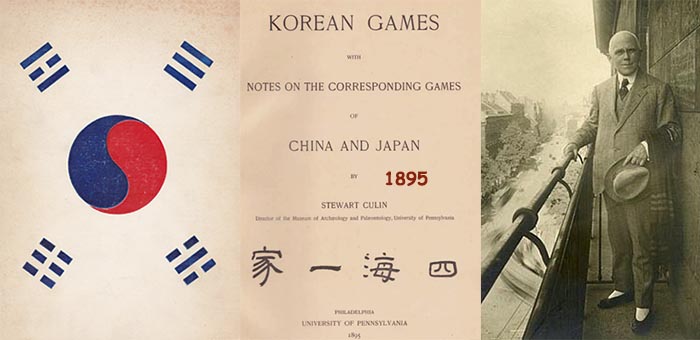
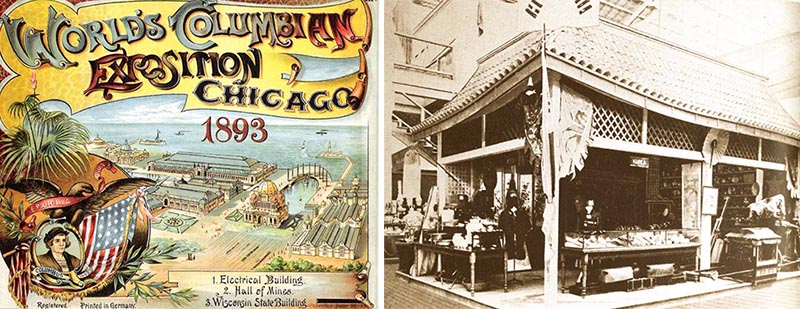
Chicago World’s Fair (1893) poster/ Joseon Exhibition Hall (right)
The World’s Columbian Exposition was held in Chicago in 1893 to commemorate the 400th anniversary of Christopher Columbus’s discovery of the New World. Korea, which established diplomatic ties with the United States in 1882, was invited along with 47 countries including China and Japan. At Korea’s first World Expo, Jeong Kyung-won, the Minister of Internal Affairs and Communications, and a ten member Korean traditional music troupe participated with a national title of “조선 (Joseon, in Korean)/ Korea (in English)” and the Taegeukgi, Korea’s national flag. The Chicago Expo was the first official stage to introduce the culture and art of Joseon to the world.
The Joseon Pavilion, which was modeled after a hanok, included a palanquin, folding screens, porcelains, official clothes, samhoejang jeogori (three color-upper garment for women), dopo (overcoat), manggeon (headband), gat(hat), beoseon (socks), fan, straw shoes, musical instruments (geomungo, yanggeum, haegeum, piri, daegeum, janggu, dangbipa, yonggo, saenghwang, etc.), and play equipment such as chess boards and kites were also exhibited. Five items of cloth, door prints, seat, mother-of-pearl and embroidery screens were awarded the medals of the Expo.
Most of the exhibits were donated to the Field Museum of Natural History in Chicago, and eight traditional musical instruments were donated to the Peabody Essex Museum (PEM) in Salem, Massachusetts. In 2003, PEM named a gallery as “Yu Kil-Chun Gallery of Korean Art and Culture” after Yu Kil-chun (1856-1914), a member of the first official delegation (Bobingsa) from Korea that traveled to the United States in 1884. After the official mission, Yu Kil-chun remained to study at The Governor’s Academy and became the first Korean student in the U.S. He went back to Joseon and wrote “Seoyugyeonmun (서유견문/ 西遊見聞/ Observations on Travels in the West).”


The genre paintings of Kim Chun-gŭn, Korean Games, watercolor, 1886
The Chicago World’s Fair 1893 introduced more than 27 million people to many modern marvels such as elevators, zippers, Cracker Jacks (snack made of caramel popcorn and peanuts), the Ferris wheel, the first voice recording, to name a few. But Stewart Culin, who participated in the Fair, was a game expert, so he paid attention to Korean play collections at the Joseon Pavilion. After interviewing Pak Young Kiu, the interpreter at the fair and the future deputy ambassador to the US in Washington, D.C., and other East Asian participants living in the US, Culin wrote a book titled “Korea Games: With Notes on the Corresponding Games of China and Japan,” which was published in a limited edition of 550 copies by the Archaeological Museum of the University of Pennsylvania in 1895. Taegeukgi was on the front of the book and the words “Four Seas of One Family (the world is one family)” in Chinese characters.
In “Korean Games,” Culin compared the games of three East Asian countries, centered on Korea, and explained a whopping 95 traditional Korean plays along with 22 watercolor paintings by Gisan Kim Chun-gŭn/Kim Jun-geun (金俊根). The illustrations were assisted by Mary Shufeldt, daughter of Admiral Robert Wilson Shufeldt, who signed the Treaty of Peace, Amity, Commerce and Navigation (Shufeldt Treaty) in 1882. Mary Shufeldt commissioned illustrations for the book in 1886 from a genre painter Kim Chun-gŭn who lived in Choryang-dong, Busan. These watercolor paintings are in the collection of the University of Pennsylvania Museum of Archaeology and Anthropology (PENN Museum).
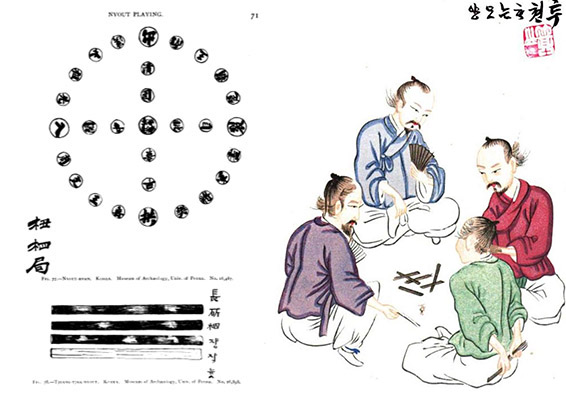
Stewart Culin, “Korean Games: With Notes on the Corresponding Games of China and Japan”, 1895 / Kim Chun-gŭn, Korean Games, watercolor, 1886
In “Korean Games,” Culin made the interesting observation: “The Korean game Nyout may be regarded as the antetype of a large number of games which exist throughout the world.” (p. 75). Nyout (Yutnori/Yut Play) is a board dice game with four wooden sticks usually played on the first day of the New Year. Five combinations of do, gae, geol, yut and mo determine how the board pieces are moved. The team that moves all four pieces around the board first wins.
Stewart Culin saw Korea as the cradle of games early on. “Korean Games” included 95 Korean plays: nyout, taldeung (toys and lanterns), snow mireuk (snowman), gaksi play (puppet play), shadow play, kite, kite-fighting, playing with a wolf, playing house, clown, and pulley , srami (bungbung), bamboo bell, mammoth turn, ragweed, thread knitting, spider web, horse teasing (stilts play), yangban play (horse riding), rinse Jiggle, jigeumjil (play with kaekeumfoot), jump rope, swing, tug of war, wrestling, taekgyeon, jegichagi, multaekgyeon (water game), bank fight, fist strike, water wall hitting, ring finding game, asking and finding, hide-and-seek, tag-catching, leg-counting game, black-catching, kodorongkkaeng, barbarian flower catching (grass fight) play), stinging, cherry-chilling, scalloping, apricot chigging, clam fighting, ball chigi, tangja throwing, gonggi nori, metal chiming, money chiming, arm chasing, side-fighting , archery game, jjakbakgi (shoe shooting), bangtongi (tuho play), Jonggyeongdo, dice, ssangryul, baduk, wellgonu, fourbatgonu, obatgonu, yukbatgonu, gonjilgonu, goal plate, hopae, pair matching, attaching tail, goalyes, dragon paddle, turtle paddle, shinsujeom, five spheres, fighting game, old bat, dongdang, riddle, character guessing, goal matching, chojungjong, etc..
However, many traditional Korean games disappeared during the Japanese occupation.
Korean plays for the 24 seasonal days
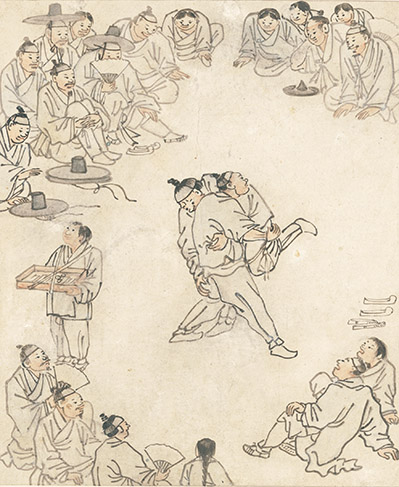
Kim Hong-do (1745-1806), Ssireum/Wrestling (Danwon Genre painting Album), late 18th century, Treasure No. 527, National Museum of Korea
Dasan Jeong Yak-yong (1762-1836), a Silhak (practical science) scholar from Joseon Dynasty, wrote a book, “Mokminsimseo (Admonitions on Governing the People: Manual for All Administrators),” (1821), in which he mentioned: “Farming is the main source of life for the people of the world,” and unfolded his view of the agriculture. Since the Neolithic Age, Koreans, which have been an agriculturally oriented society, have revered the sky, which governs rain and drought, because they relied on the weather.
Among the “Three Kingdoms” written by the Chinese historian Jinsoo in the 3rd century, “Yeonggo” in Buyeo (Ancient Country), the “Dongmaeng” in Goguryeo, and “Mucheon” in Dongye, which appear in Dongyi chapter from “The Book of Wei,” are the origins of the Korean folklore. The customs of offering sacrifices to heaven were closely woven with farming for each season, and various rituals and games were performed and food was served.
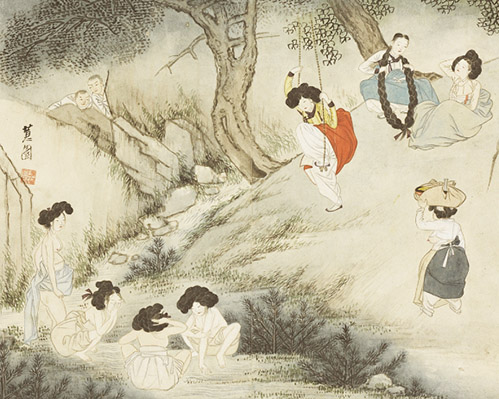
Shin Yun-bok (1758-1814), Dano Pungjeong (端午風情, Hyewon Genre Painting Album), early 19th century, National Treasure No. 135, Gansong Museum of Art
During the agricultural season, New Year’s Eve, there were plenty of Sesi-nori (seasonal customs). New Year’s Day’s play begins on New Year’s Eve (of the Lunar calendar). Start with flying a kite on the morning of New Year’s Day, we ate rice cake soup, and enjoyed playing yut, neolttwigi (jumping from seesaw), playing with Seunggyeongdo (government official game), and donchigi (playing with money). During Daeboreum (Jan. 15, lunar calendar), stepping on earth, juldarigi (tug-of-war), stepping on bridges, raising rice poles, barley plowing, high fight, wooden iron fight, Dongchae fight, seokjeon, manguri spinning, torch fight, stepping on bronze bridge, tile-tapping, mask play, stone battle war, and jwibulnori (setting fire) took place. The lion dance is famous in Bukcheong, Hamgyeong Province in the north and Deulnorieum (mask play) and Ogwangdae (five clowns' mask performance) were popular in Gyeongsang Province in the south.
On the third day of March, when the blooming spring comes and the swallows from Gangnam/south return, they went out to the mountains and fields to play all day in the mountain (Flower Outing) such as flower viewing, arranging flowers, making willow flute, and eating azaleas pancakes. On the third day of March, they made and ate bell-shaped mountain rice cakes, gori and mugwort rice cakes, and also brewed alcohol with various flowers or fruits in each region, such as Dugyeonju (azalea wine), Byeokhyangju (rice wine), Gyedangju (distilled liquor with cinnamon and honey), and Seohyangro (flower or fruit wine).
On the Buddha’s birthday in April, a lotus lantern festival and going around the pagoda were held in the temples, followed by shadow play, manseokjungnori (puppet play), waterplay, and fireworks at night. On Dano (Suriday, 5th day) in May, the day when yang energy is the most abundant of the year, a ceremony was held to pray for a bountiful harvest. And women washed their hair in iris water and made her hairpin to ward off evil spirits. The village youth went from house to house collecting straw to make a swing, and men and women dressed up to play on the swing. The elders played or watched Ssireums (wrestlings) in the yard. Mask dances and mask plays such as Bongsan Mask Dance, Songpa Sandae Nori, and Yangju Byeolsandae Nori were performed at the market in each region. Gangneung Dano Festival was registered as Korean Intangible Cultural Heritage No. 13 and UNESCO Oral and World Intangible Cultural Heritage in 2005.
There is a custom of washing hair in the water flowing to the east and bathing to prevent and purify the water on the day of the full moon in June. On the hot day (Bok Nal) they played Takjok (濯足), where they dip their feet in the water or a stream under a mineral spring or waterfall, and enjoyed a picnic. In Jeju Island, a water bathing ritual, held during the full moon, is believed to cure illness, and the water is also drunk as medicine.
You may have noticed that Korean traditional games originated from folk beliefs. Our ancestors believed in gods who protect nature and their lands. Exorcisms were performed to increase crops and animal well-being; singing and dancing were popular activities.
On the 7th night in July, Koreans held the Geolgyo Festival, where they set up sewing and fruits in the yard and pray for improvement in our sewing skills by looking at the stars. The full moon in July is a quiet time after the third weeding is over. On Baek-jung Day (15th of July of Lunar calendar) farmers reward good farmhands with allowances to eat, drink and shop in the market. And the best servants of the household with the best farming are selected and put on cows to play around the village. Dure (collective labor) workers who were hired for farming enjoyed playing "Dure-eating" (hanging homi, Putgut, drinking and eating) all day to relieve the fatigue of labor.
There’s a saying “Farmer in May, Hermit in August.” May is the busiest season in farming, and August is the time to spend leisurely like a legendary hermit living in the mountains. Since the full moon in August and Chuseok are harvest seasons, they ate songpyeon, half-moon shaped rice cake, made from fresh grain, held a ceremony, and enjoyed cooking using pine (matsutake) mushrooms. Plays include Ganggangsullae (circle dance) under the moonlit night that symbolizes abundance. Also Kwaeji Nachingching (tug of war), Jishin stepping (treading the god of the earth), palanquin fighting, Dongchae fight, weaving game, bullfighting, mask game, ssireum, bullfight were played. In the central region, there were plays in the form of a cow or a tortoise mask game, both appearing in Ten Symbols of Longevity.
On Jung-gu (9th day of Lunar calendar) in September, when swallows from Gangnam return, farmers took a break from busy harvest season, eating chrysanthemum wine and chrysanthemum pancakes, and enjoyed the autumn leaves. October is the best month (Sangdal) to give thanks for the harvest. It is said that all ancient Jecheon rites (ceremony of offering sacrifices to heaven) were performed in October. In Sangdal, they picked an auspicious day and performed Gosa rites to offer a sacrifice to spirits. Seongju-gut (shaman ritual) was held in Honam region, Dodang-gut in Seoul and Gyeonggi-do, and Mangok Grand Festival in Jeju Island.
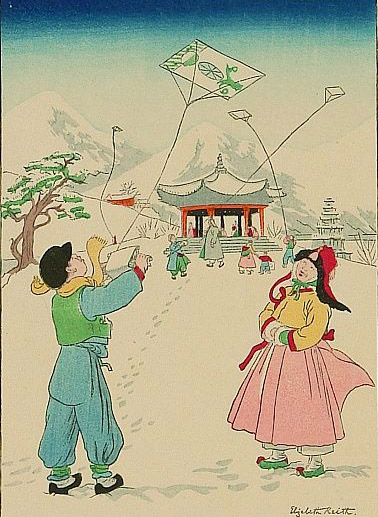
Elizabeth Keith(1887-1956), Korean Kite, 1922
On the winter solstice day (Dongji, December 22 or 23 of the Solar calendar), when the night was the longest, red bean porridge was made to dispel the bad luck. On the last day of the year, on New Year’s Eve, the court held a ritual “Narye” to ward off evil spirits and to pray for the peace of the country and people. Meanwhile, the people set fires to chase away evil spirits as well. After midnight, there were female Bokjori (hanging bamboo strainers for blessing) sellers on the street. It was believed that if you put money, food, matches, or a long string in Bokjori and hang it in the corner of a room or kitchen, good luck will come. Family and relatives gathered to play yut and enjoy flying kites.
Koreans have always balanced labor and play through games on holidays, market days, sports events, and festivals. Although many customs were discontinued during the Japanese colonial period, some plays have been passed down in their original form to this day, while others have evolved according to the times. Even for the digital savvy children in the 21st century, traditional games have physical, intellectual, emotional, and social values that cultivate traditional cultural consciousness, develop physical strength, enhance language and expressive abilities, and help social skills.
The UNESCO Intangible Cultural Heritage of Humanity includes Korean plays such as Ganggangsullae, Namsadangnori, Yeongsanjae, Jeju Chilmeoridang Yeongdeunggut and Cheoyongmu (2009), Jultagi-tightrope walking and Taekkyeon-traditional Korean martial art (2011), Nongak-community band (2014), Tugging rituals and games (2015), and Ssireum (2018).
Lee “Faker” Sang-hyeok, the superstar of video games
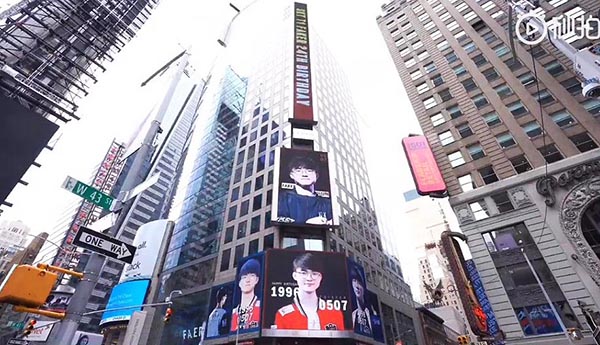
#Happy_Faker_Day @Hideonheart0507
“The Land of the Calm Dawn has mastered the art of war, and emerged as home to the most renowned StarCraft players on Earth. Do not arrive idle to this melee.”
- Players Online 2,512 (at the introduction of the Korean server for the multiplayer video game StarCraft, 2017)
Korea’s world-leading IT infrastructure has enabled almost every home to have broadband Internet access, turning every home into a potential gaming station. In the field of e-sports, which competes through video games, Koreans boast the best gaming skills in the world. Korea has become the ultimate e-sports country. Korean gamers took the top 15 of the 2013 best-selling PC real-time battle game StarCraft series, and it was recognized as the “Korea Game Bureau.” There is a saying that “pro gamers are more difficult than entering Seoul National University.”
In 2019, Lee "Faker" Sang-hyeok (1996- ) ranked No. 1 in the game world. As of September 2022, he has earned a total of 1.36 million dollars from 59 e-sports competitions, and Mr. Lee's net worth is said to be 10 million dollars.
In 2016 ESPN, an American sports TV channel, named 20-year-old Lee Sang-hyeok compared to “the emperor of golf” Tiger Woods, basketball star LeBron James, and soccer star Lionel Messi in the article “Junior year: Faker’s achievements vs. LeBron, Messi and more.” In 2019, Forbes magazine selected Lee as one of the “30 Under 30” in the Asian entertainment/sports category, saying, “Nicknamed god of computer game ‘League of Legends,’ Faker is generally regarded in the gaming community as the greatest LoL player of all time. He led his team, SKT1, to three League of Legends World Championships, received the 2018 David Yan award for most beloved gamer and powered South Korea to international dominance in the game. Last year, he signed a contract to remain with SKT1.”
On May 7, 2019, a Chinese fan club posted a happy birthday advertisement with Lee Sang-hyeok's face on a billboard in Times Square, New York. He was only 24 years old. As of September 2022, there were 1.65 million subscribers and 338 million views of Faker’s YouTube channel (T1 Faker).
The spirit of play and K-culture
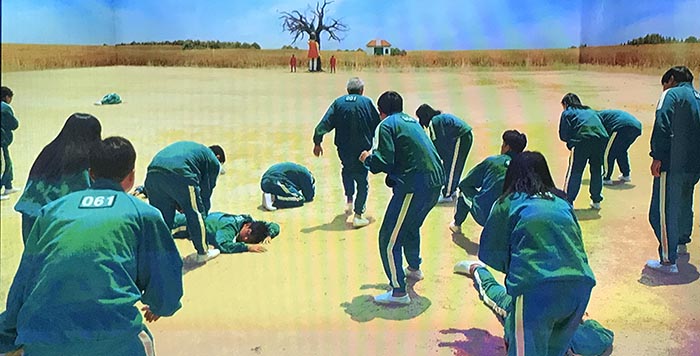
"Squid Game" Photo: Netflix
Johan Huizinga (1872-1945), a Dutch cultural historian who focused on the study of games, festivals, and rituals, in his book “Homo Ludens” (1938), said, “Play is older than culture, for culture, however inadequately defined, always presupposes human society, and animals have not waited for man to teach them their playing.” So for him, play is a human activity that precedes human language, law, war, philosophy, art, etc. In other words, play is a human activity older than culture and is the origin of all cultural phenomena.
He claimed that culture itself has the character of play. Play has a cultural function. Play accompanies music and dance and evolves into a play. Play is also ceremonial, associated with festivals and religious ceremonies. There are rules in play, and it creates a competitive spirit that separates winners and losers. Play is the prototype of various sports, as well as American TV game shows, quiz shows, and reality shows such as “Jeopardy,” “Survivor” and “American Idol.” Play evolves into quarrels and litigation disputes, and play also turns into war.
One of the popular programs on Korean TV in the 1970s was “Joyful Blue and White Battle” (MBC), a game program in which celebrities competed with sports and games. Byun Woong-jeon, host of the show, established himself as the top host of the game shows and continued to host spin-offs like “Stunning Parade” and “Merry Sports Day.” In 2021, the cable channel TV Chosun revived a variety game program “Hwayo Cheongbaekjeon (Tuesday Blue and White Battle,” which adds a song contest to it.
The reason Korea is achieving outstanding results from K-Pop, K-Drama, and K-Movie to the K-Game today is probably because the spirit of play, the archetype of culture, is embedded within our people. The Koreans know how to create games and enjoy them. The Netflix blockbuster drama “Squid Game” is one of the proofs.
“Squid Game” has become a cultural phenomenon around the globe as it spread from the game “Red Light, Green Light” (무궁화꽃이 피었습니다), “Dalgona” (달고나 뽑기), and “Squid” (오징어) which Korean children played in the 1970s and 1980s. But the children’s plays in the “Squid Game” have been sublimated into a metaphor that satirically compares the fierce competition and inequality of capitalism. Although it is composed of simple shapes of a circle, a triangle, and a square (○△□), our traditional play with profound meaning has spread to social media (SNS), TikTok, YouTube, and games, and even entered an elementary school playground in Belgium. Netflix is set to release a video game, "Squid Game: Unleashed," timed with the launch of "Squid Game Season 2," debuting on December 26, 2024.
The success of Squid Game created a ripple effect, significantly boosting interest in K-Dramas, K-Games, and K-Food. In 2021, Korean restaurants, including Cote, a Michelin-starred Korean BBQ spot in New York, added Dalgona candy, a nostalgic street snack, to their menus and hosted Squid Game-themed dinner events. Other trendy Korean restaurants followed suit, embracing the Squid Game concept. Meanwhile, YouTubers began sharing Dalgona recipes, and TikTok was flooded with survival games inspired by Squid Game's Dalgona challenge.
In October 2024, just two months before the premiere of Squid Game Season 2, "Squid Game: The Experience" will open at Manhattan Mall near Korea Town. This immersive event will challenge participants to survive all six iconic games, including Red Light Green Light and Glass Bridge. The experience will also feature a Korean-inspired night market with food, cocktails, merchandise, and mini games. Korean culture has now evolved into K-Cool, captivating global audiences with its innovative storytelling and cultural impact.
Sukie Park
A native Korean, Sukie Park studied journalism and film & theater in Seoul. She worked as a reporter with several Korean pop, cinema, photography and video magazines, as a writer at Korean radio (KBS-2FM 영화음악실) and television (MBC-TV 출발 비디오 여행) stations, and as a copywriter at a video company(대우 비디오). Since she moved to New York City, Sukie covered culture and travel for The Korea Daily of New York(뉴욕중앙일보) as a journalist. In 2012 she founded www.NYCultureBeat.com, a Korean language website about cultural events, food, wine, shopping, sightseeing, travel and people.

33 Keys to Decoding the Korean Wave, Hallyu!
한류를 이해하는 33가지 코드
CONTENTS
#Prologue: 국풍인가, 국뽕인가 Dynamic Korea, Sparkling Koreans
#1 비빔밥 정신 The Spirit of Bibimbap
The secret of K-Wave's success, including K-Pop, "Parasite", "Squid Game", Ik-Joong Kang (artist), Young Jean Lee (the first Asian female playwright in Broadway), Unsuk Chin (composer), and David Chang (chef), probably originated from the blending of Korean bibimbap. Koreans are good at genre bending. Nam June Paik, "The Pioneer of Video Art," praised Korea's bibimbap spirit a long time ago.
http://www.nyculturebeat.com/index.php?mid=Zoom&document_srl=4069551
#2 빨리빨리 문화 Culture of Ppalli Ppalli
Korea was successful in quarantine at light speed in the early days of the COVID-19 pandemic, the secret of many Koreans' success is efficiency and "quickly, quickly (ppalli, ppalli)" spirit. How the once-called "Land of Morning Calm" became a master of economic growth and speed warfare today.
http://www.nyculturebeat.com/index.php?mid=Zoom&document_srl=4070443
#3 눈치의 달인들 Homo Nuncius Korean
A history of Korean-specific sixth sense and superpower "nunchi," and commentary on "Parasite" director Bong Joon-ho praising Martin Scorsese at the Academy Awards.
http://www.nyculturebeat.com/index.php?mid=Zoom&document_srl=4071064
#4 저항의 민족 People of Resistance
Bong Joon-ho and Hwang Dong-hyuk of 'Parasite' and 'Squid Game' were once blacklisted. Korean movies and dramas contain a spirit of social criticism and a strong sense of theme/message. Why? In the history of the ordeal, Koreans have consistently resisted colonial rule and dictatorship, and the candlelight vigils that impeached President Park Geun-hye have the spirit of resistance of Koreans. Bong and Hwang were both named to TIME magazine's "100 Most Influential People in the World" (Bong Joon-ho in 2020 and Hwang Dong-hyeok in 2022).
http://www.nyculturebeat.com/index.php?mid=Zoom&document_srl=4071840
#5 한(恨)과 한국영화 르네상스 Country of Trauma, Culture of Drama
Koreans have a unique sentiment of 'han'. The ethnic trauma of Koreans, such as separated families due to the division of the two Koreas after the war and the Ferry Sewol disaster, were more dramatic reality than the movies. Koreans who share their national sad feelings want more dramatic narratives and unforgettable characters. We are hungry for that. It is also the reason why Korean directors such as Park Chan-wook, Bong Joon-ho and Hwang Dong-hyeok have developed brutal aesthetics.
http://www.nyculturebeat.com/index.php?mid=Zoom&document_srl=4072876
#6 쇠젓가락 유전자 The Magic of Metal Chopsticks
Koreans use metal chopsticks unlike Chinese and Japanese. Metal chopsticks, which require high concentration and sophisticated technology, are the open secret to success in Olympic golf, semiconductor, IT, plastic surgery, piano performance, cooks, and nail salons, etc.
http://www.nyculturebeat.com/index.php?document_srl=4073422&mid=Zoom
#7 세탁의 장인들 Masters of Laundry
Koreans immigrated to the United States and succeeded in the dry cleaning business. In the snow fields of Korea, they also did laundry next to tanks during the war. Korean passion for washing also leads to art. Park Soo Keun, who recorded the highest auction price for modern Korean art at Christie's New York, enjoyed painting laundry scenes. Nam Jeong-ho's masterpiece dance 'Pallae, Womanhood Story', musicals, poetry, and even movies were inspired by washing clothes. Julian Kim and Peter S. Lee directed “Happy Cleaners (2019)”, a film about a Korean-American family's strife.
http://www.nyculturebeat.com/index.php?mid=Zoom&document_srl=4074468
#8 복(福)을 싸드립니다: 보자기, 보따리와 보쌈 Bojagi, Bottari, & Bossam
Korean patchwork, multi-colored textile cloth reminiscent of Mondrian and Klee, a bundle moved by world-renowned artist Kimsooja and Momofuku chef David Jang's bossam all have a symbolic meaning surrounding good luck, "BO". On the philosophy of wishing the blessings of Koreans which have become motifs in art and food.
Joseon, Corea, Korea
#10 호머 헐버트와 세계인들의 한글예찬 Hangul, the Korean Alphabet
#11 '오징어 게임'과 '놀이의 왕국' 코리아 'Squid Game' and Homo Ludens Koreans
#15 음주가무-노래하고 Sing
#16 음주가무-춤추고 Dance
"The Figure Skating Queen" Yuna Kim (*TIME 100 in 2010) has the DNA of a dancer, and the only Asian principal dancers at the Mariinsky Ballet (Russia), Kimin Kim, and at the American Ballet Theater (Hee Seo, and Joo Won Ahn) are Korean. Korean dancers have been winning awards at international ballet competitions and breaking dance competition "Battle of the Year''. Of course, dance is an essential part of K-Pop.
The Power of Koreans
#20 82년생 김지영 도서 한류 열풍 K-Books and Korean Feminism
#24 '비디오 아트의 선구자' 백남준과 후예들 Nam June Paik and His Descendants
#25 K-클래식: 정경화에서 임윤찬까지 콩쿠르 강국 The Korean Musical Mystery
#26 비틀즈 Vs. 방탄소년단 The Beatles vs. BTS
#27 입양한인 예술가들 K-Adoptees Shine in the Art World
K-Culture Renaissance
#29 K-Art 단색화 부활하다 The Revival of the Korean Monochrome Painting
#31 K-Beauty 성공 신화 The Myth of K-Beauty
#32 K-Spa '한국 스파의 디즈니랜드' 찜질방 Jjimjilbang, The Disneyland of Korean Spa
#33 K-Quarantine 기생충, 킹덤과 코로나 팬데믹 K-Quarantine: "Parasite" "Kingdom" and Pandemic
Bong Joon-ho's movie "Parasite" (2019) and the Netflix zombie drama "Kingdom" seem to have foretold the COVID-19 pandemic. "We live in Bong Joon-ho's dystopia," the New York Times said in a review of Parasite. We had to maintain a six-foot "line" during the pandemic, like the lines of Parasite. New York Magazine said in July 2020 that Kingdom heralded the pandemic under the title "Kingdom Feels Like a Nightmare of Now."






 '오징어게임' 에미상 제 1차- 4개 부문 수상‥비영어 드라마 최초
'오징어게임' 에미상 제 1차- 4개 부문 수상‥비영어 드라마 최초


한국의 놀이가 95가지나 있었다는 사실도 놀랍지만 이것을 발굴한 민속학의 슈트어트 컬린이 있었기에 가능했음을 알았습니다. 슈트어트 컬린이 브루클린 박물관에 큐레이터로 있으면서 700개이상의 한국의 놀이게임을 소개한 공로는 정부차원에서 치하해야 마땅하다고 사려됩니다. 윷이 세계 수많은 놀이의 원형이라는 것도 알았습니다.
어렸을때 실뜨기 공기놀이 줄넘기등을 하면서 재밌게 놀던 추억이 납니다. 어찌나 놀이에 열중했던지 머리가 산발이 됐었습니다.
가사 도우미 아즘마가 저녁먹으라고 데리러 올때까지 식음을 전폐하고 놀았습니다. 게임에 빠진 사람들이 끼니도 잊은체 놀이에 몰두하는 걸 알듯합니다.
사내아이들은 팽이위에 크래욘으로 색색칠을 해서 돌리면 총천연색 활동사진을 보는 느낌이었습니다. 이처럼 풍부한 게임왕국을 탄생시키게한 조상들이 물려 준 DNA에 경의를 표합니다.
오징어 게임이 에미상 작품상을 받기를 응원합니다.
정약용의 목민심서를 읽고싶은 도서목록에 넣었습니다.
-Elaine-